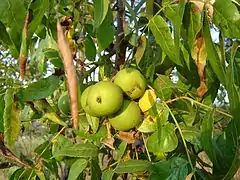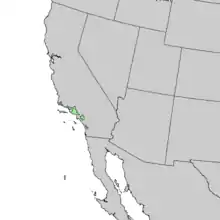| Juglans californica | |
|---|---|
 | |
| Scientific classification | |
| Kingdom: | Plantae |
| Clade: | Tracheophytes |
| Clade: | Angiosperms |
| Clade: | Eudicots |
| Clade: | Rosids |
| Order: | Fagales |
| Family: | Juglandaceae |
| Genus: | Juglans |
| Section: | Juglans sect. Rhysocaryon |
| Species: | J. californica |
| Binomial name | |
| Juglans californica | |
 | |
| Natural range | |
Juglans californica, the California black walnut, also called the California walnut, or the Southern California black walnut,[1] is a large shrub or small tree (about 20–49 feet (6.1–14.9 m)[3]) of the walnut family, Juglandaceae, endemic to the Central Valley and the Coast Range valleys from Northern to Southern California.
Distribution
Juglans californica is generally found in the valleys and adjacent slopes of the California Coast Ranges, Transverse Ranges, and Peninsular Ranges. It grows as part of mixed woodlands, and also on slopes and in valleys wherever conditions are favorable. It is threatened by development and overgrazing.[1] Some native stands remain in urban Los Angeles in the Santa Monica Mountains, Hollywood Hills, and Repetto Hills. J. californica grows in riparian woodlands, either in single species stands or mixed with California's oaks (Quercus spp.) and cottonwoods (Populus fremontii).
Description
Juglans californica can be either a large shrub with 1–5 trunks, or a small, single-trunked tree. The main trunk can fork close to the ground, making it look like two trees that have grown together, then diverged. It has thick bark, deeply channeled or furrowed at maturity. It has large, pinnately compound leaves with 11–19 lanceolate leaflets with toothed margins and no hair in the vein angles.[4] It has a small hard nut in a shallowly grooved, thick shell that is difficult to remove.
Uses
Food
The nuts are edible[5] and are eaten by the Chumash Indians of the Channel Islands of California and Ventura County as well as by the Tongva of Los Angeles County. They are not grown commercially as food.
Cultivation
Juglans californica is cultivated throughout California to support the walnut industry, used as a rootstock in English walnut orchards. It is also cultivated as an ornamental tree where it is planted in California native plant, xeriscape, and wildlife habitat gardens and natural landscaping in California, and in Hawaii.
Taxonomy
Some authorities (e.g. the California Native Plant Society) combine this species with Juglans hindsii. On the other hand, a 2007 molecular analysis of the genus[6] suggests J. californica is sister to the remaining black walnuts (section Rhysocaryon). This article follows the conventions of The Jepson Manual.[7][8]
References
- 1 2 3 Stritch, L.; Barstow, M. (2019). "Juglans californica". IUCN Red List of Threatened Species. 2019: e.T35154A61524825. doi:10.2305/IUCN.UK.2019-2.RLTS.T35154A61524825.en. Retrieved 19 November 2021.
- ↑ Essa, Lora. "Index of Species Information". U.S. Department of Agriculture, Forest Service. Retrieved April 10, 2013.
- ↑ "California Black Walnut Trees | City of Walnut, CA". www.cityofwalnut.org. Retrieved 2019-10-17.
- ↑ Kershner, Mathews, Nelson, and Spellenberg, National Wildlife Federation field Guide to Trees of North America, 2008, Chanticleer Press, Inc. p. 229
- ↑ Elias, Thomas S.; Dykeman, Peter A. (2009) [1982]. Edible Wild Plants: A North American Field Guide to Over 200 Natural Foods. New York: Sterling. p. 247. ISBN 978-1-4027-6715-9. OCLC 244766414.
- ↑ Aradhya, M. K, D. Potter, F. Gao, & C. J. Simon: "Molecular phylogeny of Juglans (Juglandaceae): a biogeographic perspective: Tree Genetics & Genomes (2007)3:363–378
- ↑ Juglans californica S. Watson var. hindsii Jeps.
- ↑ Juglans hindsii Jeps. ex R. E. Sm.
Further reading
- Anderson, E. N. "Some preliminary observations on the California black walnut (Juglans californica)" in Fremontia: A Journal of the California Native Plant Society. January 2002.
External links
- Jepson Manual Treatment – Juglans californica
- Ecology
- Juglans californica – U.C. Photo gallery
- Interactive Distribution Map for Juglans californica Archived 2012-06-06 at the Wayback Machine
